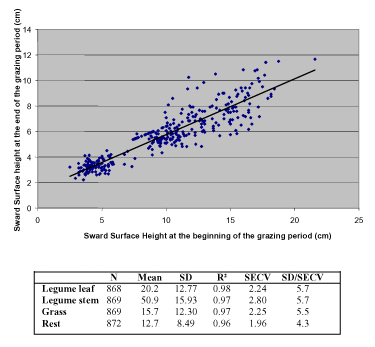Context
Grazed grass remains, far ahead, the cheaper feedstuff of high quality when well managed. In order to reach such a target, we must ensure a good sward persistence and intake.But what are the characteristics, either biochemical or morphological, to promote, through genetic selection process, to improved these sward parameters ?
Objectives
This project have three main objectives :
* to advice farmers in their variety choice to reseed their grazed grasslands, on the basis of the quotation of these varieties persistence and palatability under grazing.
* to define morphological and biochemical characters to promote in order to improve these two sward parameters.
* to develop the analytical tools necessary to quickly define the morphological and biochemical characters of interest on a great number of samples, especially through the use of Near Infra Red Spectrometry (NIRS) technique.
Expected results
The last step lies in the definition of the potential links existing between variety palatability index and the different morphological and biochemical characters taken into account. The first results underline the significant impact play by the organic matter digestibility to explain the observed palatability index variations.Results obtained
Results, obtained by misters Limbourg and Lecomte, on multi-sites and multi-annual trials, under real grazing conditions, underline repeatable persistence differences between perennial ryegrass varieties in association with white clover. These observations highlight the interest to take this parameter into account to give farmer advice in their variety choice to reseed their permanent grazed grasslands.
Concerning sward palatability definition, we have got over different steps.
We demonstrated (Stilmant et al., 2005) that, even if white clover (WC) has a significant impact on sward preference, the differences of white clover occurrence observed between the different perennial ray-grass varieties were not strong enough to significantly modified the classification of these varieties from their palatability point of view. So perennial ray-grass varieties persistence, measured through their relative abundance within the sward, and palatability are, both, quantified within the same experimental disposal.
Thereafter we focussed on focus on the definition of a ‘palatability index’ (PI). A first index has been proposed by D. Leconte. It took into account the difference of sward surface height (SSH) before and after grazing on the final SSH. This index, strongly correlated to another index taking the ratio between the SSH difference and the initial SSH, is, unfortunately, dependent of this initial SSH : higher is the initial SSH, higher will be the final SSH (Fig. 1).
In order to solve this problem and to have an PI independent of the initial SSH, we use, as PI, the difference between the observed and the expected, in relation to the initial SSH, final SSH. This difference being reported to the expected final SSH.
Once this index defined, we have tried to identify morphological and/or biochemical characters that could have an impact on its value. To do so, we first developed NIRS calibrations to characterise species and morphological composition of perennial ryegrass – white clover mixed swards, developing, in this way, the approach performed by Leconte et al. in 1999.
This approach, performed in collaboration with INRA (Domaine Expérimental Fourrager du Vieux Pin and UMR Production du Lait) and UCL (ECOP), allows us to predict, on the one side, the species composition of a sward (graminae, leguminous (white clover, red clover, lucerne) and other species) and, on the other side, its morphological composition (leaf versus stem ratio) for graminae as for leguminous species. Concerning the quality of NIRS tool developed, the ratio ‘Standard Deviation of the population / Standard Error in Cross Validation higher than 3 for all these calibrations underline their good performances (Tab. 1). Such NIRS calibrations also exist for the definition of sward biochemical characteristics.
Contribution
The Farming Systems Section is the project leader. It is occupied of the establishment and the follow-up of the project, as of the analysis of the results.Partners
R. Delagarde – INRA, UMR Production du Lait.
B. Deprez – UCL, ECO
P. D. Leconte – INRA, Domaine Expérimental Fourrager du Vieux Pin.
P. Luxen and D. Knoden – asbl Fourrages Mieux.
CRAW off coordinator
Ing. Yves Seutin
CRA-W – Section Systèmes agricoles
Rue de Serpont, 100
B-6800 Libramont-Chevigny
Tél. : +32 (0)61 23 10 10
Fax : +32 (0)61 23 10 28
Email : seutin_yves@cra.wallonie.be
Funding
- CRA-W - Walloon Agricultural Research Centre
- asbl Fourrages-Mieux



